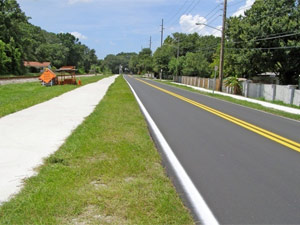Concrete vs Asphalt

If you want to look at concrete and asphalt along side each other, look at these pictures under a street-light after dark and in daylight. In daylight the conversion of sun rays into heat and released volatiles is even more pronounced. You can also see that concrete requires less artificial light at night because it reflects light better. The less energy used in lighting the better, because fossil fuels are usually burned to generate electricity, thus adding greenhouse gases to our environment.
Night time and daytime pictures showing reflectivity of concrete vs. asphalt. Asphalt requires more lighting at night to provide the same visibility as concrete. More lighting means using more electricity which is usually generated with fossil fuels.


Asphalt absorbs sunlight and converts it into heat. In the hot summer sun it can reach over 140°. This is a big contributor to the Heat Island problem in urban areas. Even when the sun goes down it continues to give off heat, adding to our air conditioning load at night. (More electricity) Once the temperature rises above 90° engine emissions are converted into smog. The National Center for Atmospheric Research (NCAR) reports that Volatile organic emissions increase by 15% to 25% for every 1.8° F. temperature increase.
What difference do heat islands make? Asphalt degrades with heat and this accelerates in heat islands. It softens and forms ruts or ripples as brakes applied to vehicle tires pushes around softened asphalt. After many thousand deflections ruts, humps or potholes form.
This is why asphalt need so much maintenance. The softer asphalt also offers more resistance to trucks requiring up to 10% more fuel. That also adds more heat and green house gasses, adding to global warming.
The Economic Implications
The main reason asphalt gets chosen over concrete is the false conception that it costs less, but here are a few things that get overlooked.
- Maintenance – Asphalt pavement is usually comprised of asphalt cement, aggregate and additives. The ingredients are mixed under heat and then usually transferred to trucks which keep the material hot and flexible until it is placed and rolled. Under constant exposure to sunlight and its UV rays, as well as the moisture from rain, snow and condensation, asphalt pavement ravels, cracks and deforms. Thus depending on traffic, requires coating or repaving every 7 to 15 years. Ironically the heat islands caused by black pavements increases maintenance costs. By contrast, properly placed concrete may not need maintenance for 40 to 50 years. Additionally dripping oil and grease damage asphalt. They can be cleaned off concrete without damage. Concrete is much more durable!
- What you don’t see – Asphalt cement is a residue of petroleum refining. In the oil refining process heat causes lighter components such as gasoline, naphtha, kerosene, diesel and other bi-products to evaporate, be condensed and processed, leaving a heavy thick brown or black sludge called asphalt that is usually “cut back” with some other hydrocarbon volatile which softens the asphalt. Much of the color comes from carbon black which initially is effective in blocking and absorbing the suns rays. The asphalt cement is formed from long, molecular chains of heavy hydrocarbons which are held together by cross linking, shorter molecular chains. This molecular network gives the asphalt pavement its initial strength and flexibility properties.
-
Aging – Sunlight and moisture attack the molecular chains in that pavement surface causing the chains to break, releasing aggregate and carbon black from the surface, as well as volatile pollutants. Thus the surface turns grey and the asphalt cracks and softens. Ridges, tears and cracks form, resulting in potholes. The presence of water (rain etc.) weakens the molecular bond between the asphalt and the aggregate adding to the problems above. This requires patching or repaving. As the pavement ages volatile organic compounds are released as pollutants into the atmosphere, and this increases with repaving. Even though, in most cases, the top of asphalt is milled to reduce repavement cost by just applying a top dressing, the expense and inconvenience are significant. When added to the initial cost, asphalt pavement becomes much more expensive than concrete.

- Asphalt costs and sustainability – The cost of asphalt cement and additives is directly affected by the cost of oil. As the price of oil rises, more fuel products are extracted during refining, and less asphalt sludge is left. This results in un-budgeted price hikes, shortages and delays. For this reason the asphalt paving industry is being driven to recycle most used asphalt, but this requires the addition of asphalt cement or other petroleum based additives to the recycled material. Cement’s availability is vast though it is, at times, limited by mining activity and the production of cement plants. This can be increased. Asphalt supply is limited by the shrinking oil reserves.
